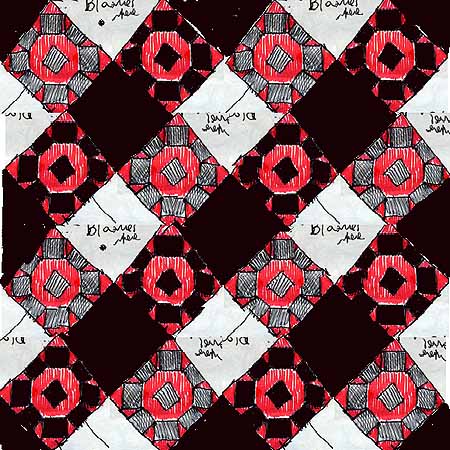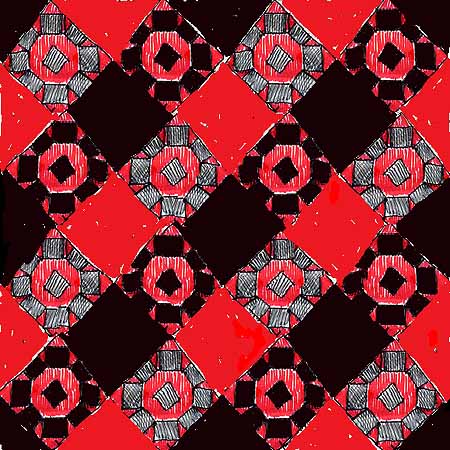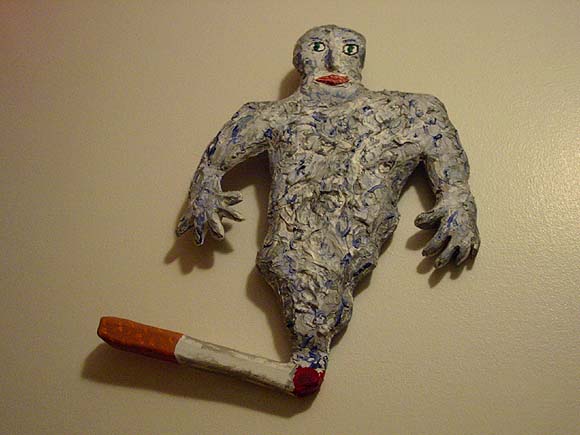View current page
...more recent posts


I took some notes on an early 20th C. quilt show at the American Folk Art Museum a few years ago and am just now getting around to processing them. For the above pattern, I had a sketch of one complete tile and notes on how the others went. These "computer recreations" (woo) are accurate except there were 6 rows, not four, and I believe the white diamonds (tinted red in the bottom jpeg) were black, or grey.
Tom Tomorrow thinks October Surprise the First was when Reagan cut a deal with the Iranians--"I'll give you guns if you wait till my inauguration day to release the hostages." He explains, therefore, it was kind of a "secret surprise." This is contorted. The actual history was, the October Surprise was what the Republicans feared in the 1980 election--that Carter would somehow secure hostage release right before the election. As long as we're exploding myths about the Carter era, do you think Carter wore a sweater to demonstrate energy conservation? Well, wrong! See this earlier post on the subject. It makes Republicans mad because they love their folklore as much as the Dems.
More on the increasing evidence that Pres. Bush cheats by using a wire in public appearances (including the debates): according to Dave Lindorff, who's been covering the story for Salon and Counterpunch, the Letterman Top 10 is emblematic that the media intends to treat it as a joke. The US media, that is. Lindorff says he was interviewed for an extensive story on Bush bulge that ran on international CNN but not in America.
The New York Times got criticized for calling Jacques Derrida abstruse in its obit headline, so it ran a Derrida-lovin' editorial (scroll down) by academic Mark C. Taylor as a way of making amends. Taylor declares Derrida, Wittgenstein, and Heidegger "the three most important 20th Century philosophers"--a thesis topic that reads like a TV news headline. It's like, all three must be continental philosophers, and we need one post-structuralist. So Derrida edges out Foucault and Lyotard because D. just died. The piece attempts to humanize him and make him warm and fuzzy for Times readers, talking about how important religion was to him. But Taylor's description of deconstruction mutes its dark side: as I understand it, Derrida was saying all sentences were hegemonic, i.e., territory conquering--Taylor softpedals that as "working by exclusion." Thus we don't use "grammatically correct," tightly-constructed sentences to study sentences, we play complex, punning language games that tease out their biases and inadequacies, which Derrida could apparently do well but not everyone has a gift for. The result is legions of mediocre sub-Derridas ensconced in college departments, making students hate reading. That's one reason Derrida's death is a slightly charged issue--it's not just because the neocons hate him.

The friendly spirit who lives in a cigarette watches over my kitchen and reminds me to eat my vegetables. The sculpture is by Thor Johnson, ca. 1990.
My predecessor Eyebeam reBlogger Beverly Tang has posted photos from her summer roadtrip, from the West Coast to Tennessee and back. My favorite are her shots of skies and sunsets from the moving car, particularly on the Arizona and Texas, Oklahoma, Arkansas parts of the trip. They're crisp, striking images in terms of pure old-fashioned photographic values, but they also conjure for me the loneliness of that part of the country, where I lived and drove for years--places where some days the sky is the only thing happening (that and cafeteria shootings).
Like everyone else in the blogosphere, I enjoyed watching Jon Stewart attack the CNN Crossfire hosts on their own show (I saw the Windows Media clip via BitTorrent). The only problem is the confrontation took place on Crossfire, which means reaction shots of the guffawing audience, a pre-prepared graphic of Stewart's softball Kerry questions designed to make Stewart look weak and stupid, the emphasis on gotchas and zingers that seems to be TV's sole reason for being, and, worst of all, the presence of the two toxic hosts, doing their best to get the better of their guest. Stewart's admission that he watches their show every day considerably weakened his case in my eyes. Attacking the show on the show innately smells of co-opting--it just provides more "good television."
From today's New York Times Magazine article on the zealotry of the Bush inner circle (and true believers everywhere), written by reporter Ron Suskind (liberated version here):
In the summer of 2002, after I had written an article in Esquire that the White House didn't like about Bush's former communications director, Karen Hughes, I had a meeting with a senior adviser to Bush. He expressed the White House's displeasure, and then he told me something that at the time I didn't fully comprehend -- but which I now believe gets to the very heart of the Bush presidency.Here's hoping that come November we get to collectively say, "Yeah, well, study this, motherfucker."
The aide said that guys like me were ''in what we call the reality-based community,'' which he defined as people who ''believe that solutions emerge from your judicious study of discernible reality.'' I nodded and murmured something about enlightenment principles and empiricism. He cut me off. ''That's not the way the world really works anymore,'' he continued. ''We're an empire now, and when we act, we create our own reality. And while you're studying that reality -- judiciously, as you will -- we'll act again, creating other new realities, which you can study too, and that's how things will sort out. We're history's actors . . . and you, all of you, will be left to just study what we do.''
